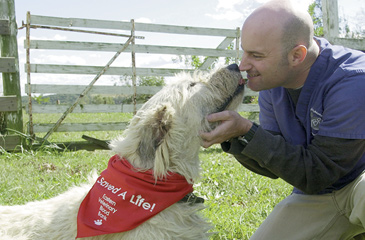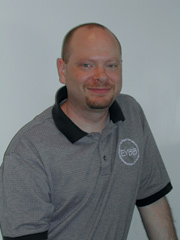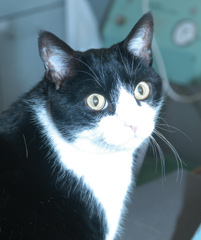Canine Volunteers
By Carolyn Lee
Perhaps it is fitting
that a black and white cat named “Boomer” (after star
quarterback “Boomer” Esiason of the University of
Maryland Terps and the Cincinnati Bengals) would be the official
greeter at the Eastern Veterinary Blood Bank (EVBB), a facility
where, according to its logo, “Dogs [are] Saving Dogs’
Lives…Voluntarily.”
The key word, says co-founder Patrick Lee, Jr., is “voluntarily.”
He summarizes the concept of humane blood banking in this way.
“Every single one of the dogs who donates to our program
is a companion animal, either somebody’s pet or somebody’s
working dog.” And he emphasizes that as an all-volunteer
blood bank, EVBB “wants to be the template for how veterinary
blood banking is done as this industry expands.” To illustrate
the “volunteer” concept, Lee explains, “We don’t
farm blood from people in prisons—the Red Cross [operates]
on a donor system,” and so does EVBB.
 In addition to the concept of humane blood banking is the importance
of following humane blood banking standards. Says Lee, “We
wanted to elevate veterinary blood banking a few notches. When
we started 10 years ago, many of the issues we faced were in terms
of lack of education in this field. [We find] we’re not
having to answer those questions as much any more. We have elevated
transfusion medicine, and we’ve done a good job of educating
our clients.”
In addition to the concept of humane blood banking is the importance
of following humane blood banking standards. Says Lee, “We
wanted to elevate veterinary blood banking a few notches. When
we started 10 years ago, many of the issues we faced were in terms
of lack of education in this field. [We find] we’re not
having to answer those questions as much any more. We have elevated
transfusion medicine, and we’ve done a good job of educating
our clients.”
Lee reminds us that when we take our beloved pets to donate blood,
[we’re] accomplishing more than just that simple donation.
Says Lee, “[You] are not only saving lives with the blood
product but furthering a volunteer system and proving that it
can work.” Lee points out that “the only people who
draw blood from our donors are licensed veterinarians. That is
not the case for other blood banks.” He explains that, although
an argument could be made that drawing blood is a technician’s
job, EVBB feels strongly that “until the standards in veterinary
medicine are policed the same way they are in human medicine,
having licensed vets do that job is the best guarantee that things
are being done right.”
In fact, the staff at EVBB has designed strategies for ensuring
that blood collection is consistently a positive experience. To
develop a level of comfort, the dogs and their owners are walked
through the procedure, and the dogs are rewarded with tummy rubs
and treats. During the actual blood drawing, most of the dogs
are “cradled” or “embraced” by the blood
collection assistant who lies with them on the table. Larger dogs
can be comforted in other positions or on the floor. Some owners
may even practice these positions with their dogs at home so nothing
seems strange on appointment day.
We often hear about blood shortages in human medicine in the form
of a plea from the American Red Cross. Says Lee, “If you
took that concept and increased it exponentially, that’s
the demand/supply curve in veterinary medicine. There are not
remotely enough blood product and blood banks to service the veterinary
communities’ need.” The hope of EVBB, as expressed
by Lee, is that “we inspire the dog-loving population enough
so that it’s sort of a right of passage that their dog donates.”
Lee says it would sound something like, “My dog does his
community service (or civic duty)—he donates blood.”
After all, he says, “You have a dog that does search and
rescue or a guide dog for the blind, and people are very proud
when that’s the case. But it takes a lot of training for
dogs to be able to participate [in those activities]. For those
of us with a lazy pooch and no time, here’s your done-in-a-day
community project, and you’ve given back in a half-hour.”
If EVBB plans come to fruition, says Lee, “We could expect
to see blood banks open up regionally.” The main donor base
for EVBB is Annapolis and, although the site on Bestgate Road
was originally selected for its central location, Lee says they
have found that “the donor population in Annapolis and Anne
Arundel County has allowed us to stay here. The facility stays
busy with twice-a-week appointments every single week of the year.”
It should be no surprise, then, that Patrick Lee is a good friend
to animals. Although he recalls as a child that his parents were
not “pet people,” he and his brother grew up loving
animals. Lee says his interests began as an advocate against mistreatment
of animals. “In fact, I’m a vegetarian because I’ve
had a long-standing opposition to factory farming.” In time,
he learned to ride horses and, while attending Earlham College
in Richmond, Indiana, was a lesson coordinator and instructor
at a local stable. Later, when he needed to put himself through
graduate school in Baltimore, he resisted his father’s suggestion
to use his skills as a carpenter and join the family construction
firm. Instead, Lee got a job training horses. When one job wasn’t
enough to make ends meet, Lee saw an ad for a receptionist/technician
at a veterinary hospital. “In my limited knowledge of the
veterinary field, I said [to myself] I could do that. What I didn’t
realize at the time was that all I had ever done with animals
had nothing to do with working at a veterinary hospital. It was
the worst job interview I’d ever done.” In the end,
the owner/veterinarian hired Lee for his carpentry skills to make
improvements to the facility—and that is where he met Rosemary
Kendall, the hospital manager.

Patrick Lee, Jr., co-founder of
Eastern Veterinary Blood Bank.
The emergence of the Eastern Veterinary Blood Bank begins in this
chance encounter. Lee describes how the convergence over time
of a handful of key people resulted in its creation. He remained
at the veterinary hospital for nine months and says, “I
was fascinated with the whole veterinary [experience]. I applied
myself to how a veterinary hospital runs and what technicians
do.”
When Rosemary Kendall left to run an emergency hospital in Catonsville,
she called Lee for help. “I was there for about two and
a half years,” says Lee, “and ended up as one of their
head overnight technicians, learning a whole lot more about veterinary
medicine.”
This scenario was not, however, falling in line with Lee’s
original career strategy. “My master’s degree is in
corporate management. The plan all along was to combine that with
my East Asian [undergraduate] studies to make myself indispensable
to some multinational company or some government agency.”
Instead, Lee describes the point in time when Dr. Ann Schneider
enters the picture. “She had just purchased the Catonsville
Animal Hospital. Having left an academic and teaching environment
at the [well-respected] Animal Medical Center (AMC) in New York
City, she soon found that running a single-doctor practice was
not something she was prepared to do.”
Fresh out of graduate school, Lee knew Schneider needed a business
function. “She was not trained to manage the practice and
was feeling overwhelmed. The hospital encouraged me to stay and
assist her personally by putting in place the [necessary] business
systems.” Lee stayed a few months and left “Dr. Ann”
with a qualified technician named Cindy Brucksch.
Over time, Lee says, “Dr. Ann realized that there were many
aspects of running a private specialty practice that were too
emotionally trying.” Schneider had been involved in the
blood bank and hematology studies at AMC. In a conversation with
one of her mentors, as Lee tells it, “Dr. Ann said, ‘Wouldn’t
it be neat if a real need in veterinary medicine, like blood banking,
could actually provide someone with a career?’”

“Boomer” is the official greeter at the blood bank.
Lee says that was the moment when the lightbulb went off for Schneider.
“She called me in Indiana and asked if a blood bank could
be a viable business. I offered to do a market study and came
out in February of 1993. By September we were up and running—and
every single one of those people is still involved at some level.
Cindy Brucksch was our original donor coordinator and Rosemary
Kendall is one of our shareholders, working here now to train
some people.”
Eastern Veterinary Blood Bank is a small company of about 12 people.
Says Lee, “There are several departments within the company:
a shipping department that has to follow various regulations;
a processing department that follows even more stringent regulations;
our donor coordinating department which recruits and sets up the
donor trips, our client services department which gives advice
to our veterinarians and sells them the products they need; our
blood-drawing teams; and our administration department.”
When the crews arrive in the morning, says Lee, “If they
are seeing appointments in house, they set up the exam room. If
they’re going on the road, the crews load up one of our
two bloodmobiles and go to an off-site location to meet donors.”
While the crews are drawing blood, the other departments are fielding,
processing and packaging orders. Lee says the orders are shipped
all over, “to every state in the U.S. with the exception
of California and Hawaii. We also ship to Argentina, the Bahamas,
France and Great Britain.
While the blood bank has a broad reach across our state and national
borders, Lee believes EVBB should be intently involved in the
local community. EVBB sponsors such organizations as Maryland
Therapeutic Riding and Leadership Anne Arundel.
In his personal life, Lee reveals the same compassion for animals
at home as is evident in his work. He lives on Kent Island with
his wife, Theresa (who also works at EVBB), son Michael, two dogs
and three cats. He says, “When I got married, my wife’s
dog came with her and my dog came with me. They both had been
in accidents and their owners couldn’t pay [the vet bills],
so we each ended up adopting them.” Lee says they look like
twins with “the same back leg bent in the wrong direction.”
The EVBB has nine blood drive locations in Maryland and a considerable
number of volunteers in the Baltimore-Annapolis area. But the
canine blood bank, like the American Red Cross, frequently runs
into blood shortages. Says Lee, “If we could just get the
word out that dogs can donate blood to save other dogs’
lives…I think we could start to close the gap between supply
and demand.”
The Eastern Veterinary Blood Bank is located at 808 Bestgate Road
in Annapolis, next to the Anne Arundel Veterinary Emergency Clinic,
with which they share a close association. For more information,
call 410-224-3527 or visit www.evbb.com.
When not wearing one of her hats for Inside Annapolis Magazine, Carolyn Lee
can be found paddling her kayak or working in her garden.
|
Back
|

